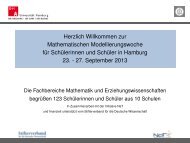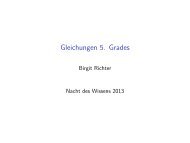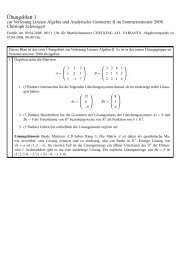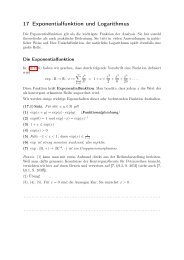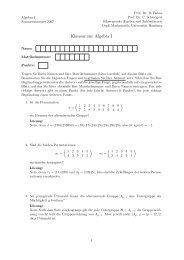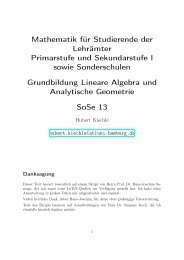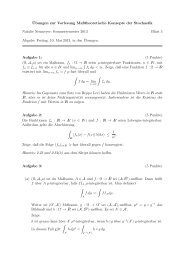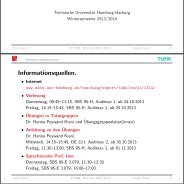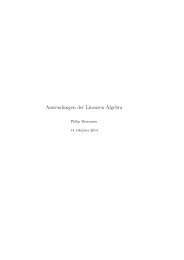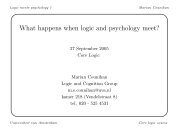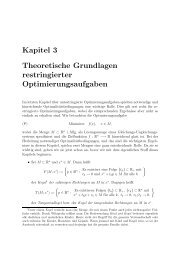pdf file
pdf file
pdf file
Create successful ePaper yourself
Turn your PDF publications into a flip-book with our unique Google optimized e-Paper software.
5.4 Topological field theories of Turaev-Viro type<br />
We now discuss the construction of a three-dimensional topological field theory which can be<br />
seen as a three-dimensional cousin of the two-dimensional topological field theory constructed<br />
in example 4.1.14 on 2-manifolds with a triangulation. Our exposition closely follows [BK1].<br />
We work with a three-layered structure involving manifolds of dimensions 1,2 and 3. It<br />
comprises in particular a three-dimensional topological field theory<br />
Z T V :<br />
Cob(3, 2) → vect(C)<br />
in the sense of definition 4.1.5. In particular, we have to achieve the following goals:<br />
• To closed oriented three-manifolds, we want to assign an invariant with values in End C (I).<br />
This invariant should be a topological invariant.<br />
• To closed oriented two-manifolds, we want to assign a finite-dimensional complex vector<br />
space. To a three-manifold M with boundary representing a cobordism ∂ − M −→ M<br />
∂ + M,<br />
we want to assign a linear map. This expresses a locality property of our invariants.<br />
• We want to go one step further and assign categories to closed oriented 1-manifolds.<br />
Thus we have as a zeroth layer categories associated to closed oriented 1-manifolds. At<br />
the first layer, we will have not only closed surfaces, but also 2-manifolds with boundary.<br />
After having chosen an object for each boundary circle, we get a vector space which depends<br />
functorially on the choice of objects. On the third level, we have three-manifolds with corners<br />
relating the 2-manifolds with boundaries. In particular, we obtain invariants of knots and<br />
links in three-manifolds generalizing the constructions of the previous subsection and thus<br />
to representations of braid groups.<br />
This can be formalized by using bicategories, defining a bicategory Cob(1, 2, 3) of 1-2-3<br />
cobordisms, leading to the notion of an extended topological field theory. For an account, see<br />
[L, Section 1.2] and for an informal account see [NS].<br />
We stick here to a low key approach.<br />
Definition 5.4.1<br />
Let K be an algebraically closed field. A fusion category is a rigid, K-linear semisimple tensor<br />
category with finitely many isomorphism classes of simple objects and finite dimensional spaces<br />
of morphisms. We assume that End C (I) = Kid I .<br />
We restrict to the ground field K = C. The following proposition will be used:<br />
Proposition 5.4.2. [ENO, Theorem 2.3]<br />
If C is a spherical fusion category over the field C, then the so-called global dimension of C is<br />
non-zero:<br />
D 2 := ∑ (dim V i ) 2 ≠ 0 .<br />
i∈I<br />
(We do not suppose that a square root D of the right hand side has been chosen; the notation<br />
will just be convenient later.)<br />
Observation 5.4.3.<br />
1. All manifolds are compact, oriented and piecewise linear. We fix as a combinatorial datum<br />
a polytope decomposition Δ, in which we allow individual cells to be arbitrary polytopes<br />
(rather than just simplices). Moreover, we allow the attaching maps to identify some of<br />
134




